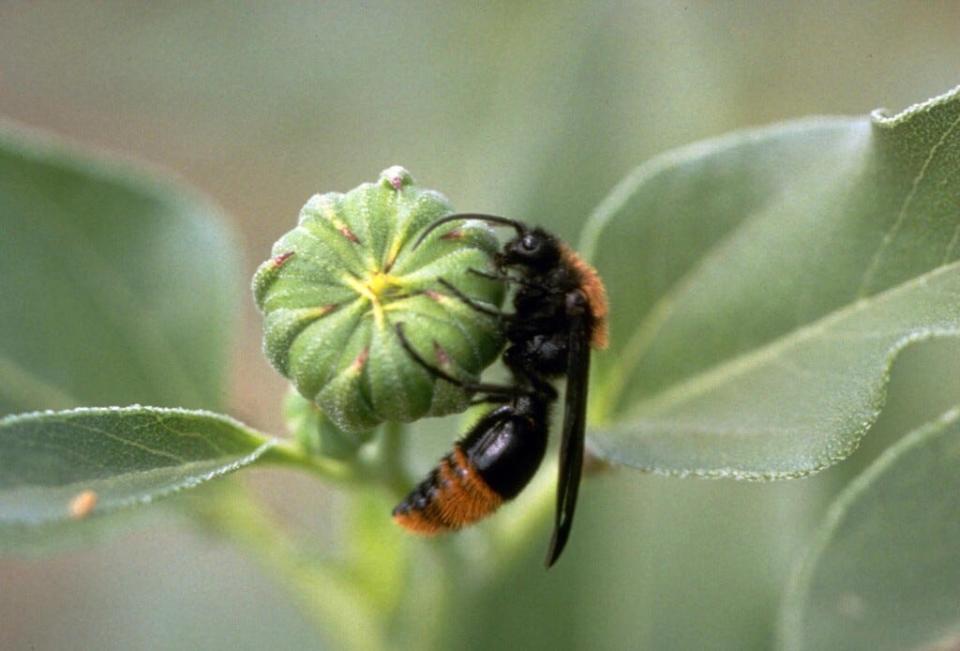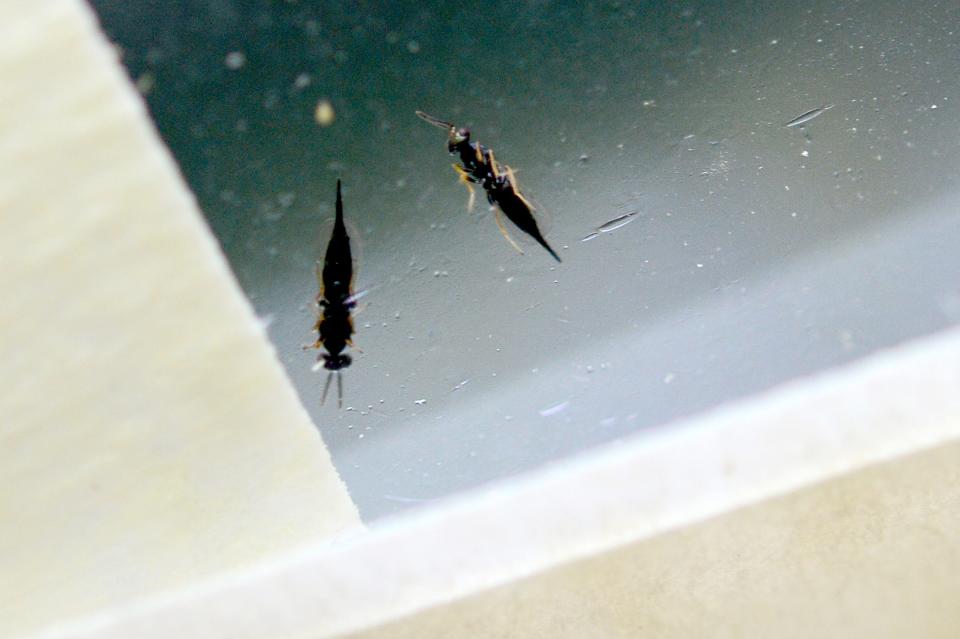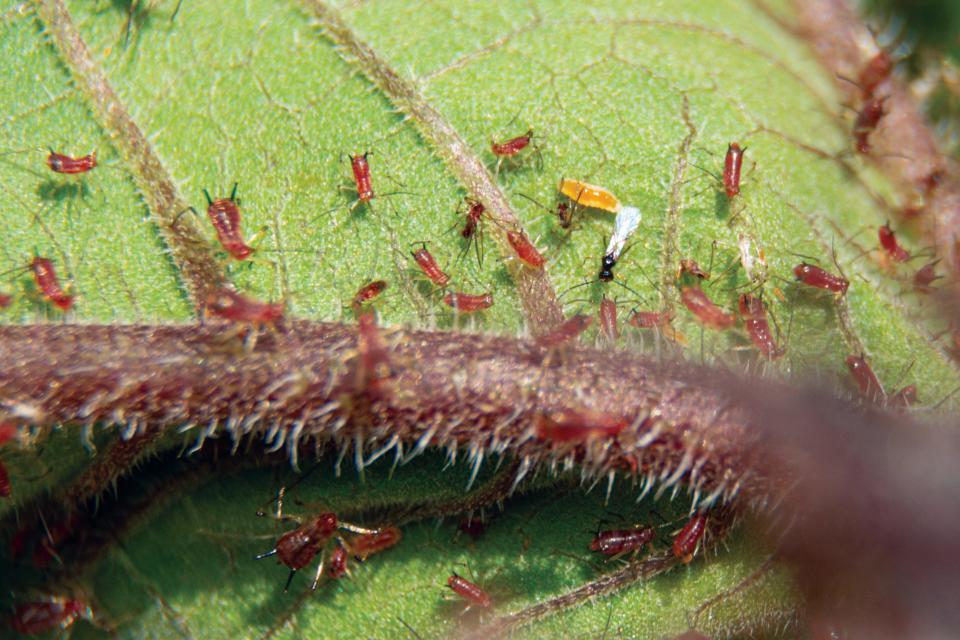Goetze: These little wasps pack a wallop when it comes to natural pest control
Whenever I asked students to tell me how insects were ecologically important, two of the most common responses were “as plant pollinators” and “some insects were vectors/carriers of diseases.”
It seemed that the ecological role of controlling population numbers of other insect species was either overlooked or not assigned as much importance as the insects’ previously mentioned economic and medical impacts.
Almost all of my students knew that insects, such as ladybird beetles, were beneficial pest controllers in crops, gardens and yards; however, very few realized the tremendous impact parasitoid wasps also have in similar ecological settings.
Picky parasitoids
The wasps are called parasitoids because they lay their eggs either on or inside of insect hosts and the host is eventually killed as the larvae hatch, feed and metamorphose into adults.
Many wasps, such as mud daubers, yellow jackets, hornets and others, seek out a variety of invertebrate and insect prey for their larvae.
But some of the parasitoid wasps in our region are very choosey concerning insect hosts for their eggs and seek out one kind of insect or larvae as living incubators.
These particular wasps choose aphids, larval lepidopterans — butterfly caterpillars — and even the larvae of other wasps. The most commonly encountered of these wasps are referred to as Ichneumon, Trichogrammatid, and Braconid wasps, and velvet ants.
Natural helpers
Ichneumons, Trichogrammatids and Braconids are commercially farmed and sold for release into fields, gardens, and orchards as biological — living — control agents of insect pests.
An advantage of utilizing these types of wasps for biological control is that most other beneficial arthropods —ladybird beetles, praying mantids, spiders, etc. — are largely unaffected by the wasps and thus are free to continue their own pest removal activities.

Braconid, Ichneumon and Trichogrammatid wasps are usually small in size: 215 mm for Braconids; 3–40 mm for most Ichneumon wasps; and 0.3–1.0 mm for Trichogrammatids.
And many species have quite lengthy, specialized ovipositors that appear to be fearsome stingers but are actually only used to deposit their eggs into or on specific host insects.
Therein does not lie the sting
In fact, most of these small wasps are incapable of stinging humans. The wasps’ abdomens are long and slender, and their wings may even be partially fringed on the edges.
Body colors vary from blacks and browns to yellow, orange and red, and the wasps’ antennae are often lengthy and sometimes clavate — club-shaped on their terminal ends — as compared to the shorter antennae of other wasps.
The color of these wasps’ eyes varies from dark black or brown to red or pink and, in their size and characteristics, some of the Trichogrammatids more closely resemble gnats than wasps.
Little wasps with a big impact
The lifecycles of many of these wasps are short, sometimes being completed within only a few weeks. However, whenever these parasitoid wasps appear in numbers, each female wasp may deposit from 50 to a few hundred eggs in appropriate insect hosts.

Usually a single egg is laid on or in the host’s body; therefore, each female Braconid, Ichneumon, and/or Trichogrammatid wasp exponentially reduces insect pest numbers.
Also, considering that, with appropriate conditions, the eggs hatch and produce even larger succeeding generations/populations of adult wasps, the biological control effects are even more multiplied!
Interestingly, the female wasps can determine the ratios of male and female offspring. The mother wasp lays an unfertilized egg if a male wasp is desired. But female wasps hatch from fertilized eggs.
Some of the most common hosts of these three types of parasitoid wasps include insect eggs, aphids, cutworms, hornworms, various species of flies and some beetle species.
Female aphid wasps sting and immobilize adult aphids, deposit an egg inside the aphid and essentially turn the active, green aphids into immobile, brown-colored mummies!
Adult parasitoid wasps feed upon nectar, aphid honeydew and/or fluids of their chosen larval hosts. Most foraging and reproductive activity occurs during the day and many of the adults rest in and on trees and other vegetation at night.
A velvet insect
Contrasting the small, parasitoid wasps are the much larger, and conspicuous velvet ants. These large wasps are densely covered with hair as opposed to the usually smooth, bare and glossy appearance of other wasps.
Females are wingless, ground-dwelling and vaguely resemble very large ants — especially due to their gray to black colors and bold red to orange spots and/or bands on the abdomen.
Males are winged and are larger than females but, otherwise, are hairy and have similar red to orange abdominal markings.
'Cow killer'
Also, unlike the aforementioned wasp species, female velvet ants can deliver very painful stings with their long, effective ovipositors/stingers.
One common name of the velvet ant is "cow killer"; perhaps referring its painful sting or ability to sting through normally adequate, protective clothing.

I once — and only once! — picked up a female velvet ant while wearing welder’s gloves and soon learned that even those thick gloves didn’t provide enough protection!
Male velvet ants do not sting but, instead, fly in search of adult females. Whenever a female is located, the male often snatches her from the ground and engages in a mating flight.
Velvet ants are diurnal and search for ground nests of yellow jackets, other wasps, bees, and, occasionally, beetles and flies.
Once an appropriate nest is located, the female velvet ant often must force her way into the nest and lay her eggs near the larvae or pupae of the host.
Velvet ants have exceptionally hard exoskeletons to protect them from attack by the nest’s owners and their warning coloration discourages other predators. Velvet ants also produce loud chirping and/or clicking warning sounds whenever threatened.
As we have discussed, some of our area’s smallest wasps can have great, beneficial effects on our crops, gardens, and orchards and, despite their appearance, are harmless to humans and pets.
Velvet ants are exceptional in their ability to defend themselves but are solitary and non-aggressive. Whenever outdoors, you need not be concerned with the small parasitoid wasps but make sure to respect the velvet ants/cow killers!

Jim Goetze is a retired professor of biology and former chairperson of the Natural Sciences Department of Laredo College with an avid interest in all aspects of the natural world. He can be contacted at gonorthtxnature@gmail.com.
This article originally appeared on Wichita Falls Times Record News: Goetze: These wasps are small but mighty for pest control

